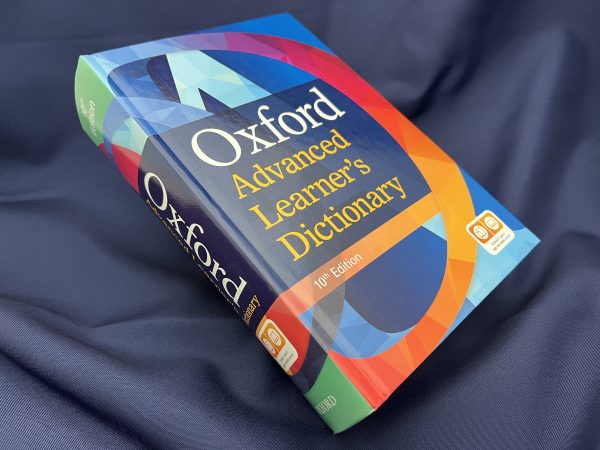In 2020, the 10th edition of the Oxford Advanced Learner’s Dictionary, or OALD, was published. The origin of this dictionary can be traced back to the Idiomatic and Syntactic English Dictionary (ISED), the world’s first fully-fledged English-English dictionary for English language learners. ISED was edited by A. S. Hornby and others, who were invited from the United Kingdom to engage in English education in Japan, and was published by Kaitakusha in 1942. 2022 marked the 80th anniversary of the ISED. During that time, as English was established as the international language of communication, the rivalry between different publishers, together with the development of (applied) linguistics and lexicography, has contributed to the ongoing evolution of monolingual dictionaries for language learners.
Since the mid-1990s, the quality of information has improved, and monolingual dictionaries have become easier to use. The key concepts are “corpus basis” and “user-friendliness”. To appreciate what kinds of changes have occurred, let’s compare the entries of acknowledge in the 4th edition (1989) and the 10th edition (2020) of OALD.
Firstly, compared to the 4th edition, the 10th edition is easier to read; it is printed in two colors with each definition written on a new line. The OALD has been printed in two colors since the 6th edition (2000). Furthermore, in the 10th edition, notice these symbols next to the headword:
The Oxford 3000 and The Oxford 5000
The key symbol (
The key symbol with a plus sign (
*Find out more about the Oxford 3000and the Oxford 5000 wordlists.
https://www.oxfordlearnersdictionaries.com/wordlists/oxford3000-5000
Common European Frame of Reference (CEFR)
The Common European Frame of Reference divides foreign language competencies into six levels – A1, A2, B1, B2, C1, and C2. Words from the Oxford 3000 are labeled
The Oxford Phrasal Academic Lexicon (OPAL)
*Find out more about OPAL.
https://www.oxfordlearnersdictionaries.com/wordlists/opal
Grammar notation
Turning our attention to the 4th edition, we can see the first meaning of acknowledge contains these codes [Tn, Tf, Tw, Ca·n, Cn·t]. They indicate verb patterns. For example, [Tn] means transitive verb. Considering that this pattern was denoted by [VP6A] in the 3rd edition (1974), this is much easier to understand. Although a list of verb types could be found on the inside back cover of the 4th edition, referring to this each time was a real hassle. Though it takes up space, the grammar code is spelled out in the 10th edition (sb stands for somebody, and sth stands for something). In OALD10, these abbreviations, called “verb frames”, are written just before the corresponding example. The verb patterns and example sentences in OALD4 and OALD10 are summarized in the comparison table below. The clarity of the 10th edition is self-explanatory.
Shortcuts
Returning to OALD10, you’ll notice that each definition is preceded by a word or short phrase capitalized in blue and marked by a dot such as
The influence of corpuses
Since the introduction of the Collins COBUILD English Language Dictionary in 1987, the use of corpuses has become an integral part of dictionary editing. Corpuses provide vital data on the frequency of usage for each word, and this influences every stage of lexicographic editing from identification and selection of headwords, through sense division and arrangement, identification of grammatical and lexical patterns, to the presentation of examples. Let’s look at how the entries of acknowledge are structured in OALD4 and OALD10. There are differences between the two, and the latter is based on frequency from corpus analysis.
As you can see from the comparison table above, the verb types Tw and Cn·t shown in OALD4 are not included in OALD10. Based on corpus analysis, the frequency may not have been high enough. Frequent patterns such as acknowledge the fact are highlighted in bold in the examples.
The most recent editions of English-English dictionaries contain accurate information, presented in a format which is easy to understand and use. OALD10 has been edited based on large corpuses and displays the most high-frequency words. Innovations, such as the integration of the Oxford 3000 and 5000 wordlists and OPAL, make it easier for users to identify core vocabulary, the Oxford 3000 also making definitions easier to understand. In addition, shortcuts and straightforward abbreviations of verb patterns make the latest edition even more user-friendly. Whilst in the past dictionaries were only available in print, now it’s easy to find online versions. In my next article, I will explore the effects of digitalization on dictionaries, particularly on the editorial processes and how people search for words.
Reference:
Yamada, Shigeru. 2020. OALD10 Katsuyo Gaido [Usage Guide]. Tokyo: Obunsha Publishing.
https://dic.obunsha.co.jp/oald10/dl_guide_book/OALD10_dic.pdf
Shigeru Yamada is a Professor at Waseda University, Tokyo. He is on the editorial advisory board of Dictionaries: Journal of the Dictionary Society of North America. He was a Co-Editor-in-Chief of Lexicography: Journal of ASIALEX. His specialization is EFL and bilingual lexicography. His recent publications include “Monolingual Learners’ Dictionaries – Past and Future” (The Bloomsbury Handbook of Lexicography, 2nd ed., Ch. 11, 2022).
